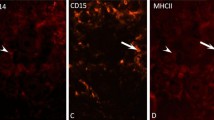Abstract
Tuftsin, a tetrapeptide (Thr-Lys-Pro-Arg) is known to potentiate the immunogenic activity of antigen-fed macrophages. The present study describes the mechanism of action of tuftsin in leprosy patients throughout the spectrum of the disease in vitro as a function of culture age in terms of (A) involvement of second messengers cAMP, cGMP and [Ca2+]i and (B) number of tuftsin binding sites/and their relative affinities on the monocytes/macrophages. There is apparently no direct involvement of either cAMP or cGMP while comparing the stimulated and unstimulated cultures during in vitro differentiation of monocytes (days 1, 3 and 7) or with the spectrum of the disease. Inhibition of superoxide anion release either by verapamil or with Quin 2 clearly demonstrated the involvement of [Ca2+]i as a second messenger during activation of monocytes/macrophages with tuftsin. Scatchard analysis of radiolabelled tuftsin binding data showed only one type of tuftsin receptor (low affinity) on BL/LL monoc ytes/ macrophages and normal and BT/TT cultures showed a gradual change in receptor number and affinities (low to high) with the maturation of monocytes to macrophages in contrast to BL/LL groups which displayed significantly less number of receptors. This study elicits a model which depicts that the biological responses/metabolic functions of early monocytes of normal and BT/TT gradually increase with the age of the culture till day 3 and tapers off thereafter in the older (day 7) cultures, whereas the monocytes/macrophages of BL/LL group are metabolically active only on day 1. The present study thereby implies that the clearance of leprosy bacilli from lepromatous leprosy lesions as a consequence of local or systemic immunotherapy (in the present study, the macrophage modulation by tuftsin) depends on the influx of new competent macrophages, rather than the local activation of resident lepromatous macrophages.
Similar content being viewed by others
References
Najjar VA, Nishiuoka K: Tuftsin–An unphysiologic phagocytosis stimulating peptide. Nature (London) 288: 672–673, 1970
Iyer RR, Prasad HK, Bhutani LK, Rao DN: Modulation of human lepromatous monocytes/macrophage function in vitro by tuftsin. Int J Immunopharmac 12: 847–858, 1990
Iyer RR, Prasad HK, Bhutani LK, Rao DN: Effect of tuftsin stimulation on the microbicidal activity exerted by blood monocytes/ macrophage of leprosy patients. Int J Immunopharmac 12: 859–869, 1990
Khare S, Bhutani LK, Rao DN: Modulation of peripheral blood derived monocytes/macrophages from leprosy patients using ‘tuftsin’ for production of reactive oxygen intermediates. Lepr Rev 64: 208–218, 1993
Johnston RB Jr, Kitagawa S: Molecular basis of enhanced respiratory burst of activated macrophages. Federation Proc 44: 2927–2932, 1985
Ridley DS, Jopling WH: Classification of the leprosy according to immunity; a five group system. Int J Lepr 34: 255–274, 1966
Boyum A: Separation of leukocytes from blood and bonemarrow. Scan J Clin Lab Invest 21: 77–89, 1968
Tsein RY, Pozzan T, Rink TJ: Calcium homeostatis in intact lymphocytes: Cytoplasmic free calcium monitored with a new intracellularly trapped fluorescent indicator. J Cell Bio 94: 325–334, 1982
Scatchard G: The attraction of proteins for small molecules and ions. Ann NY Acad Sci 51: 660–672, 1949
Stabinsky Y, Bar-Shavit A, Fridkin M, Goldman R: On the mechanism of action of the phagocytosis stimulating peptide tuftsin. Mol Cell Biochem 30: 71–77, 1980
Berridge MJ: Inositol triphosphate and diacylglycerol. Two interacting second messengers. Ann Rev Biochem 56: 159–193, 1987
Cox JD, Karnovsky MD: The depression of phagocytosis by exogeneous cyclic nucleotides, prostaglandin and theophylline. J Cell Bio 59: 480–490, 1973
Zurier RB, Weissmann G, Hoffstein S, Kammerman S, Tai HW: Mechanism of lysosomal enzyme release from human leucocytes. II Effects of cAMP and cGMP, autonomic agonist and agents which effect microtubule function. J Clin Invest 53: 297–309, 1974
Jungi TW, Hafner S: Quantitative assessment of Fc receptor expression and function during in vitro differentiation of human monocytes to macrophages. Immunology 58: 131–137, 1986
Amoscato AA, Davies PJA, Babcock GF, Nishioka K: Receptor mediated internalization of tuftsin. Ann NY Acad Sci 419: 114–134, 1983
Nogueria N, Kaplan G, Levy E, Samo EN, Kushner P, Granelli-Piperno A, Viero L, Colomer Gould V, Levis W, Steinman R, Yip YK, Cohn ZA: Defective gamma interferon production in leprosy. Reversal with antigen and interleukin-2. J Exp Med 158: 2165–2170, 1983
Hortwitz MA, Levis WR, Cohn ZA: Defective production of monocyte-activating cytokines in lepromatous leprosy. J Exp Med 159: 666–678, 1984
Author information
Authors and Affiliations
Rights and permissions
About this article
Cite this article
Khare, S., Bhutani, L.K. & Rao, D.N. Quantitative assessment of tuftsin receptor expression and second messenger during in vitro differentiation of peripheral blood derived monocytes of leprosy patients. Mol Cell Biochem 171, 1–10 (1997). https://doi.org/10.1023/A:1006861509742
Issue Date:
DOI: https://doi.org/10.1023/A:1006861509742



